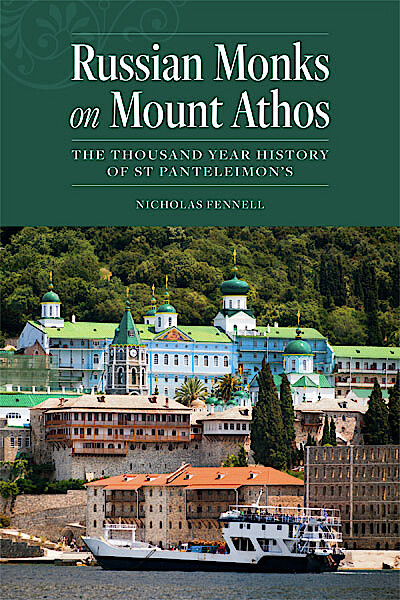Russian Monks on Mount Athos
The Thousand Year History of St Panteleimon's
- AvailablePaperback9781942699309280 pages: USD 38.95 / GBP 29.99 Add to basket
- AvailableDigital9781942699422: USD 19.99
— About the Book —
The Holy Mountain of Athos is a self-governing monastic republic on a peninsula in Northern Greece. Standing on the shores of the Aegean Sea is one of the twenty ruling monasteries that comprise the republic, that of St Panteleimon, known in Greek as the Rossikon. Its building, fully restored in recent years, can accommodate up to 5,000 men, reflecting the scale of the settlement at its apogee in the nineteenth century and prior to the Bolshevik revolution in Russia. Since the fall of the Soviet Union in 1991 the monastery has experienced a strong revival and is now among the most numerous of the twenty. But the vast buildings that can be seen today are a reflection of only the past two centuries. That the Russian presence on Athos goes back more than one thousand years is much less well known.
This book is the first comprehensive account in the English language of this millennium of history. The author has been able to draw from previously inaccessible archival materials in gathering the wealth of information he shares in this work. The history of the community is not described in geographical isolation but shown as interacting with the much wider worlds of the Byzantine and Ottoman empires and the modern nation state of Greece, together with that of the Russian homeland whose political character is constantly evolving. There are shown to be three distinct phases in this history:
- from the tenth to the twelfth centuries when Russian Athonites inhabited the ancient Russian Lavra of the Mother of God, also known as Xylourgou;
- then the six hundred years from the mid-twelfth to the mid-eighteenth century when the ancient Monastery of St Panteleimon was the Russian house on Athos, more commonly referred to as Nagorny or Stary Rusik;
- the most recent 250 years, that are naturally covered in greater depth thanks to the wider availability of sources.
Amongst the themes explored in the book are ethnic relations, the Pan-Orthodox ideal, the role of money and political pressure, sanctity and heroism in adversity, and the importance of historical memory and precedent. The author seeks to arbitrate fairly between often strongly opposing ethnic viewpoints.
It examines in detail the fluctuating fortunes of the monastic community of St Panteleimon during the past 250 years, when its ethnic identity was frequently questioned. St Panteleimon's is a history that has been blighted by Greek-Russian quarrels, mass deportation of dissenting brethren, troubles in the Caucasus, and even tangential implication in the present-day dispute between the Ecumenical and Moscow Patriarchates over Ukraine.
This text will be invaluable to both academic historians and the general educated reader who does not possess specialist knowledge. It is complemented by a timeline, glossary, comprehensive bibliography, index, full-color illustrations and photographs.
— Author Biography —
Nicholas Fennell holds a MA in Modern and Mediaeval Languages from Trinity College Cambridge, where he was a Senior Scholar, and a PhD from Southampton University. He is a member of the Friends of Mount Athos and of the Institute of the Athonite Legacy in Ukraine. The author of three previous books on Athonite Russian history, he has been researching and visiting Mount Athos since the 1980s.
— Contents —
Introduction: The Russian Monastery on Mount Athos
1 - The Monastery’s Early History: from Xylourgou to the Old Mountain Rusik
2 - From Abbot Savvas to Abbot Gerasim
3 - The Return of the Russians in the Reign of Abbot Gerasimos
4 - The New Spiritual Father and Leader of the Russian Brotherhood is Chosen
5 - The Crimean War
6 - The Greek and Russian Brotherhoods at Loggerheads
7 - The Reign of Archimandrite Makary
8 - Makary’s Successors: Abbots Andrey and Nifont 1889–1905
9 - Archimandrite Misail
10- The Name of God Dispute
11 - From 1913 to Abbot Misail’s Death in 1940
12- The Next Four Abbots: from Iustin to Avel´ (1940–1978)
13 - From Abbot Ieremiya to Abbot Evlogy
Conclusion
Timeline
Acknowledgements
Notes
Glossary
Bibliography
Index





